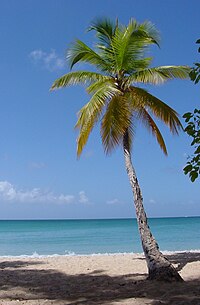
Photo from wikipedia
BACKGROUND AND AIMS The Araceae are one of the most diverse monocot families with numerous morphological and ecological novelties. Plastid and mitochondrial genes have been used to investigate the phylogeny,… Click to show full abstract
BACKGROUND AND AIMS The Araceae are one of the most diverse monocot families with numerous morphological and ecological novelties. Plastid and mitochondrial genes have been used to investigate the phylogeny, and interpret shifts in the pollination biology and biogeography of the Araceae. In contrast, the role of whole-genome duplication (WGD) in the evolution of eight subfamilies remains unclear. METHODS New transcriptomes or low-depth whole-genome sequences of 65 species were generated through Illumina sequencing. We reconstructed the phylogenetic relationships of Araceae using concatenated and species tree methods, estimated then the age of major clades using TreePL. We inferred the WGD events by Ks and gene tree methods. We investigated the diversification patterns applying time-dependent and trait-dependent models. The expansions of gene families and functional enrichments were analyzed using CAFE and InterProScan. KEY RESULTS Gymnostachydoideae was the earliest diverging lineage followed successively by Orontioideae, Lemnoideae and Lasioideae. In turn, they were followed by the clade of 'bisexual climbers' comprised of Pothoideae and Monsteroideae, which was resolved as the sister to the unisexual-flowered clade of Zamioculcadoideae and Aroideae. A special WGD event ψ (Psi) shared by the True-Araceae clade occurred in the Early Cretaceous. Net diversification rates first declined, increased then through time in the Araceae. The best diversification rate shift along the stem lineage of the True-Araceae clade was detected, and net diversification rates enhanced following the ψ-WGD. Functional enrichment analyses revealed that some genes, such as heat shock protein, glycosyl hydrolase and cytochrome P450, expanded within the True-Araceae clade. CONCLUSIONS Our results improve our understanding of aroid phylogeny using the large number of single/low-copy nuclear genes. In contrast to the Proto-Araceae group and the lemnoid clade adaption to aquatic environments, our analyses of WGD, diversification and functional enrichment indicated that WGD may play a more important role in the evolution of adaptations to tropical, terrestrial environments in the True-Araceae clade. These insights provide us with new resources to interpret the evolution of the Araceae.
Journal Title: Annals of botany
Year Published: 2022
Link to full text (if available)
Share on Social Media: Sign Up to like & get
recommendations!